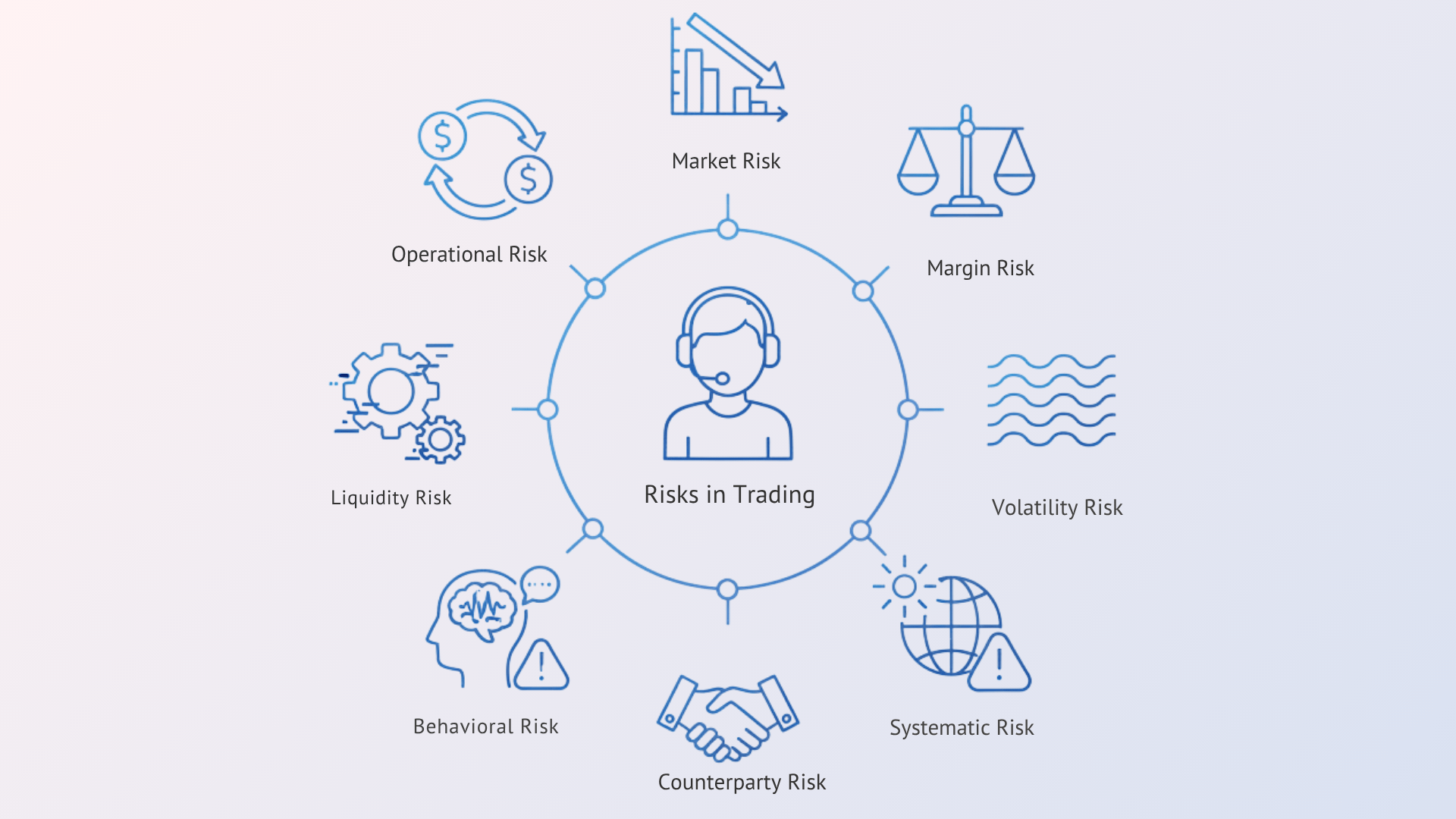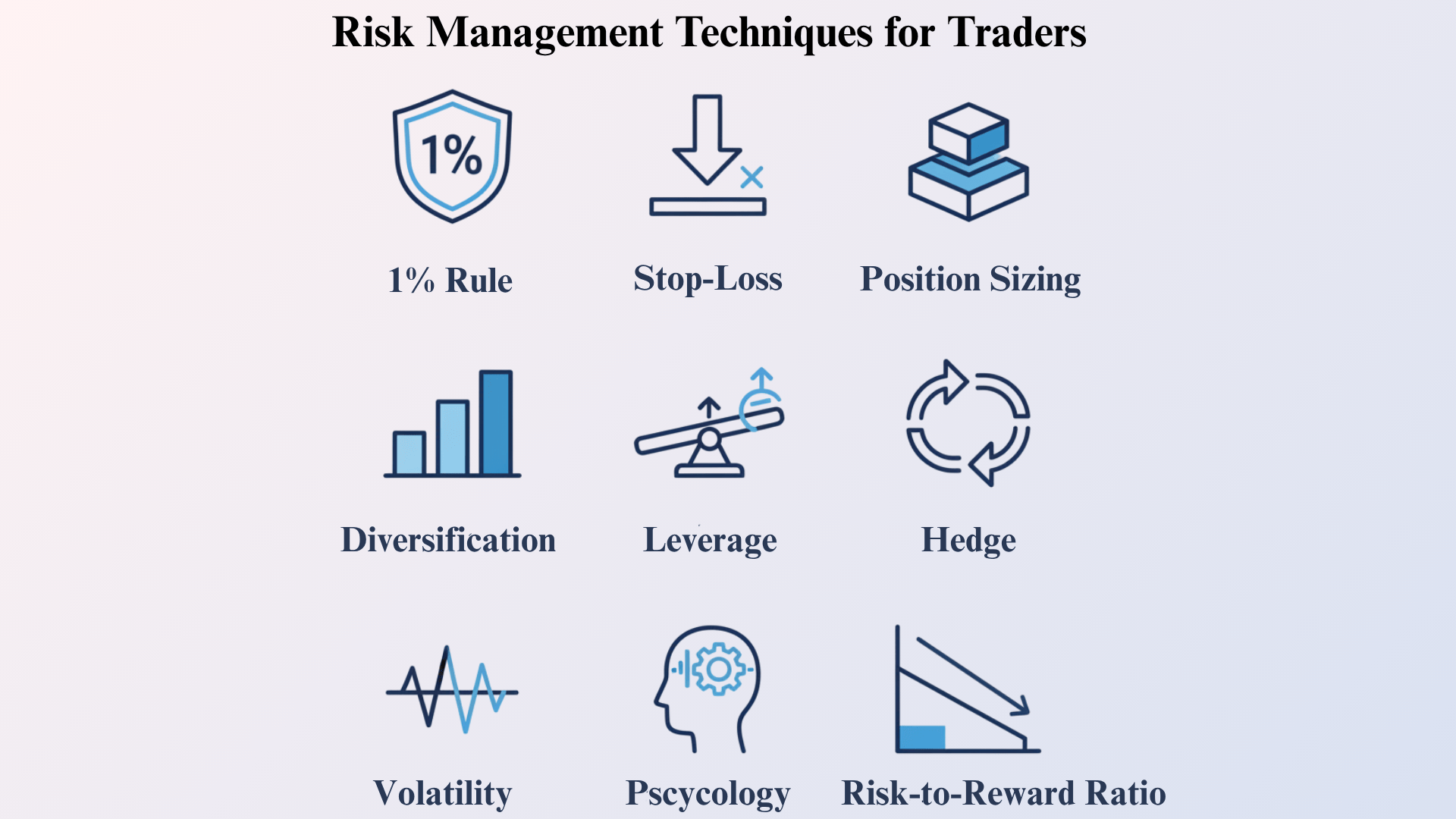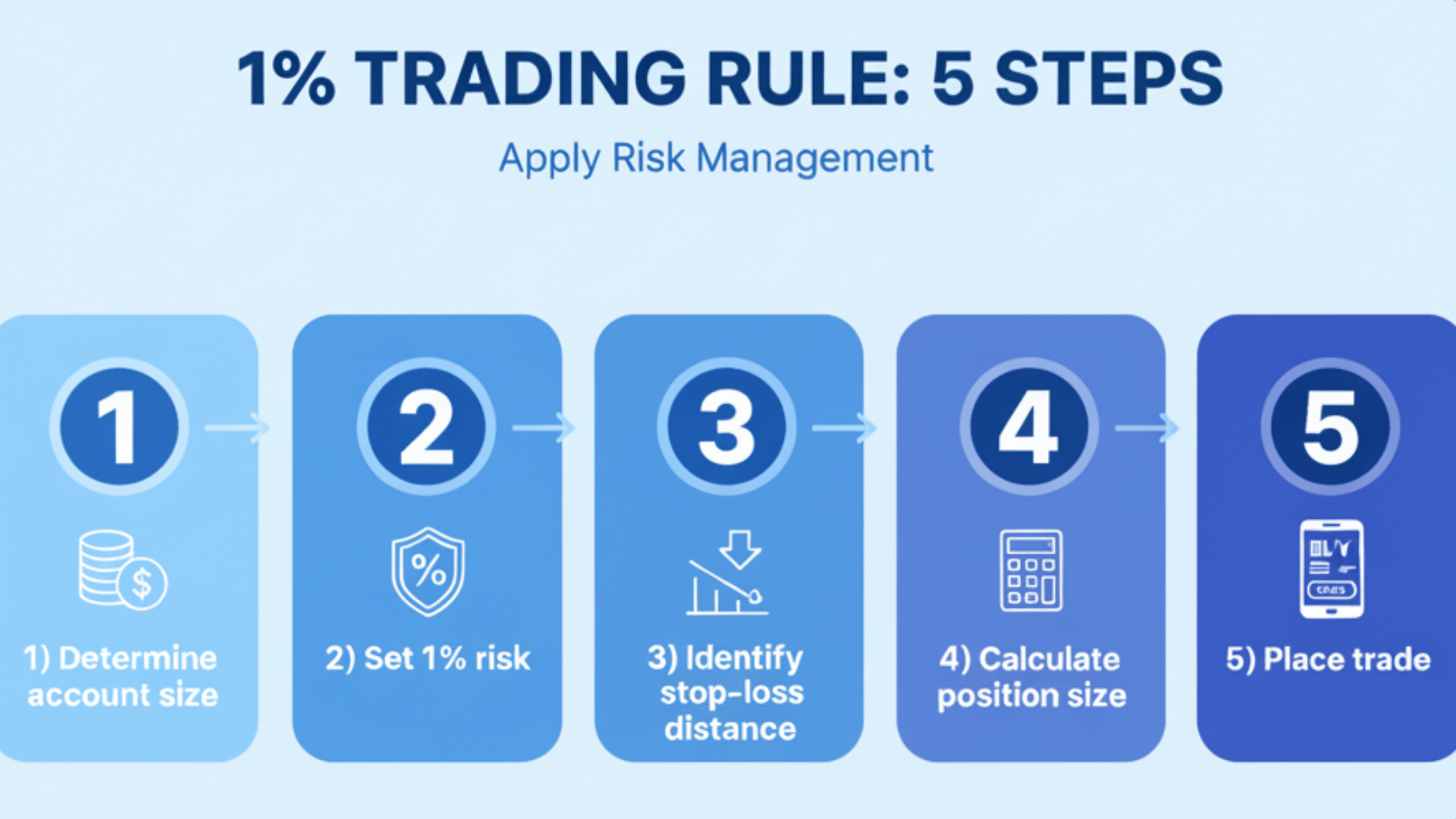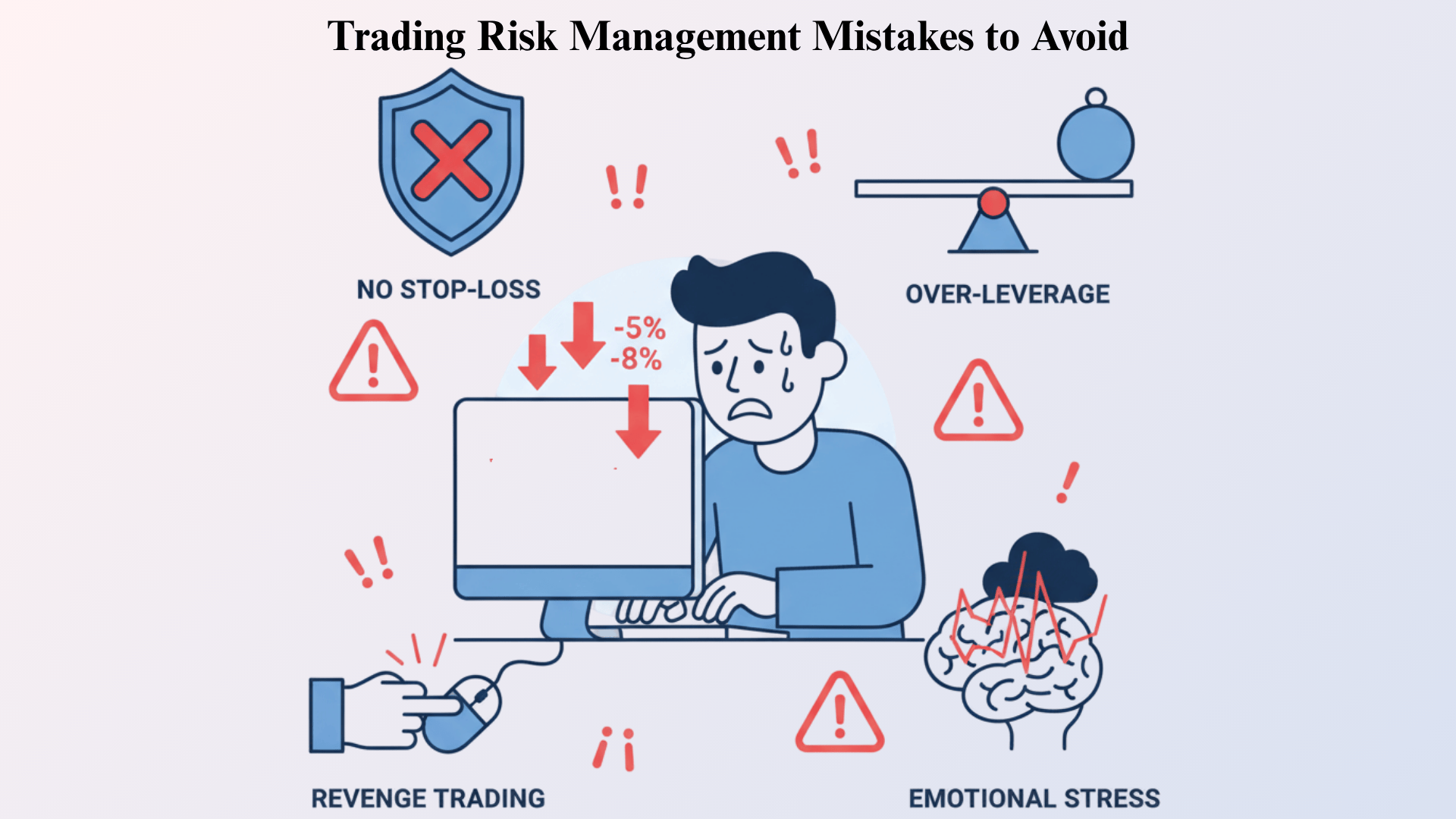In trading, profits are optional, but risk management is mandatory. Most traders fail not because they lack market knowledge, but because they don’t know how to control their losses.
One bad trade with poor risk planning can wipe out weeks of gains in minutes. The difference between traders who last and those who quit isn’t luck. It’s discipline.
In this guide, you’ll learn the types of trading risks that can hurt you, proven techniques professionals use to protect their capital, and the golden rules that keep your account safe when the market turns ugly.
Good traders focus on making money. Great traders focus on not losing it.
What is Risk Management in Trading?
Risk management in trading is the process of identifying, measuring, and controlling financial risks in your trades and portfolio.
It helps you protect your capital, stay consistent across different market conditions, and keep emotions in check when prices move fast. Without it, even winning trades can lead to heavy losses.
Core pillars of risk management include:
- Position sizing – deciding how much to risk on each trade
- Stop-loss planning – setting exit points to limit damage
- Diversification – spreading risk across assets and strategies
- Leverage discipline – using borrowed money carefully
- Trader psychology – staying calm and sticking to your plan
Pro Tip: Think of risk management as your defense system in trading. The market is unpredictable, and your job is to survive the bad days so you can profit on the good ones. Strong defense always beats aggressive offense.
Types of Risks in Trading

Every trader faces different kinds of risks, and knowing them helps you prepare better. Some risks come from the market itself, while others depend on your broker, your emotions, or even technical issues.
Here’s a breakdown of the eight main types of risk in trading that can impact your capital and decisions.
| Risk Type | What It Means | Example |
|---|---|---|
| Market Risk | Price moves against your trade. | You buy a stock, and it drops 5% fast. |
| Liquidity Risk | Hard to trade without slippage. | Low-volume penny stock with wide spreads. |
| Leverage / Margin Risk | Borrowed funds amplify losses. | 10× leverage turns a 2% loss into 20%. |
| Volatility Risk | Sudden swings hit stops or prices. | Stock gaps overnight, skipping your stop. |
| Systematic / Event Risk | Big news moves the whole market. | Fed hike drops all indices by 3%. |
| Counterparty Risk | Broker or exchange fails. | The platform crashes or the broker goes bankrupt. |
| Emotional / Behavioral Risk | Fear or greed causes bad decisions. | Panic-sell at lows or overtrade after a loss. |
| Operational Risk | Technical or input errors. | Wrong order size or frozen trading screen. |
Key Takeaway: Understanding these risks doesn’t eliminate them, but it gives you the clarity to plan around them. Most traders focus only on market risk and ignore the rest until it’s too late.
The Golden Rules of Risk Management in Trading
These rules form the foundation of successful trading. Follow them consistently, and you’ll protect your capital even when the market turns against you. Ignore them, and even the best strategy won’t save you from serious losses.
- Always Define Risk Before Entry: Never enter a trade without knowing exactly where your stop-loss will be placed.
- Trade with a Plan: Decide your entry, exit, stop-loss, and profit target before you click buy or sell.
- Use Consistent Position Sizing: Risk the same percentage on every trade to avoid random exposure that can wreck your account.
- Keep Losses Small and Manageable: Small, controlled losses let you stay in the game long enough to hit your winners.
- Never Add to Losing Trades: Averaging down on a bad position is one of the fastest ways to blow up your account.
- Cap Daily or Weekly Drawdowns: Set a loss limit for the day or week, and stop trading once you hit it.
- Risk Management > Trade Management: Even a perfect setup will fail if your position size is too large or your stop is too tight.
These rules aren’t suggestions. They’re non-negotiable habits that separate traders who last from those who don’t.
Risk Management Techniques for Traders

Mastering risk management techniques is what separates traders who survive from those who blow up their accounts. These nine methods are used by professionals. Apply them consistently, and you’ll protect your capital while giving yourself room to grow.
1. Apply the 1% to 2% Rule
The 1% to 2% rule means you never risk more than 1% to 2% of your total account balance on a single trade. This keeps losses small and gives you room to recover even after multiple losing trades. It’s a standard practice recommended by institutions like CME and used by professional traders worldwide.
How it works:
- $10,000 account → max risk per trade = $100 to $200
- $50,000 account → max risk per trade = $500 to $1,000
Why professionals use it: It prevents emotional blowouts and keeps you in the game long enough to hit your edge.
2. Set Smart Stop-Loss and Take-Profit Levels
Stop-loss and take-profit orders define your exit points before you even enter a trade. This removes emotion from the equation and ensures you lock in profits or cut losses at the right time. The key is using logic, not hope, to place these levels.
Types of stop-loss strategies:
- Static stop-loss – fixed price level based on support or resistance
- Trailing stop-loss – moves with the price to lock in profit
- Volatility-based stop – adjusted using ATR or Bollinger Bands
Take-profit logic:
- Aim for a risk-to-reward ratio of at least 1:2 or 1:3
- Example: risk $100 to make $200 or $300
Real example: You buy at $50, place a stop-loss at $48 (support), and target $56 (next resistance). Risk = $2, reward = $6, ratio = 1:3.
3. Calculate Position Size Scientifically
Position sizing is not about how much you want to trade. It’s about how much you can afford to lose. Using a formula removes guesswork and keeps your risk consistent across all trades.
Position sizing formula:
Position Size = Account Risk ÷ Stop Distance
Example:
- Account size: $20,000
- Risk per trade: 1% = $200
- Stop distance: $2 per share
- Position size: $200 ÷ $2 = 100 shares
Position sizing table:
| Account Size | 1% Risk | Stop Distance | Position Size |
|---|---|---|---|
| $10,000 | $100 | $1 | 100 shares |
| $25,000 | $250 | $2 | 125 shares |
| $50,000 | $500 | $2.50 | 200 shares |
Golden rule: Never use gut feeling to decide position size. Let the math protect you.
4. Maintain a Healthy Risk-to-Reward Ratio
Your risk-to-reward ratio tells you how much profit you’re targeting compared to how much you’re willing to lose. A good ratio means you don’t need to win every trade to stay profitable. Even a 40% win rate works if your winners are bigger than your losers.
How it works:
- Risk $1 to make $2 or more
- The higher the ratio, the fewer wins you need
Expectancy formula:
E = (Win% × Avg Win) − (Loss% × Avg Loss)
Example:
- Win rate: 40%
- Avg win: $300
- Avg loss: $100
- Expectancy = (0.40 × $300) − (0.60 × $100) = $60 per trade
Even with more losses than wins, you still make money over time.
5. Diversify Across Assets, Strategies, and Timeframes
Diversification spreads your risk so one bad trade or sector doesn’t wipe you out. It means trading different asset classes, using different strategies, and not putting all your money into one type of setup.
Ways to diversify:
- Across assets – stocks, forex, commodities, crypto
- Across strategies – combine trend following with mean reversion
- Across timeframes – mix day trades with swing trades
Pro tip: Set a weekly exposure cap per asset class. For example, don’t risk more than 10% of your account on crypto in one week.
6. Manage Leverage and Margin Responsibly
Leverage lets you control more money than you have, but it also multiplies your losses. A 5x leveraged trade can turn a 2% loss into a 10% account hit. Professionals use leverage carefully and never go all in with borrowed money.
Leverage examples:
- 1:2 leverage – conservative, limits blowup risk
- 1:5 leverage – moderate, requires tight stops
- 1:10 leverage – aggressive, used only by experienced traders
Margin call example:
- You have $10,000 and use 5x leverage to control $50,000
- Market drops 2% → your position loses $1,000 (10% of your capital)
- The broker may issue a margin call if losses continue
Avoid the trap: Never double down or use max leverage to recover losses.
7. Hedge Your Trades When Appropriate
Hedging means opening a second position that offsets risk from your main trade. It’s like insurance. You may give up some profit, but you protect yourself from big losses during uncertain times.
Common hedging strategies:
- Protective puts – buy puts to protect a long stock position
- Covered calls – sell calls against stocks you own to earn a premium
- Pair trading – go long and short on correlated assets
Example: You’re long on gold. To hedge, you short silver when its correlation spikes. If gold drops, silver often drops too, and your short position helps offset the loss.
8. Monitor Volatility and Adjust Exposure
Volatility changes how far the market can move in a short time. During high volatility, your stop-loss might get hit faster, or your position might swing wildly. Smart traders adjust their position size and stop distance based on current volatility.
Tools to measure volatility:
- ATR (Average True Range) – shows average price movement over time
- Bollinger Bands – expand during high volatility, contract during low volatility
How to adjust:
- In high volatility → widen your stop-loss or reduce position size
- Before major news (Fed, CPI, NFP) → reduce exposure or stay flat
SEO tip: Volatility-based risk management is a key strategy for professionals trading through uncertain markets.
9. Strengthen Emotional and Behavioral Discipline
Even the best strategy fails if you panic, revenge trade, or overtrade. Emotional discipline is what keeps you consistent. It’s about following your plan even when fear or greed tries to take over.
How to build discipline:
- Stick to your pre-trade checklist
- Is my risk defined?
- Is my stop-loss placed?
- Is my risk-to-reward ratio favorable?
- Did I check the news calendar?
Keep a trade journal to track:
- What worked and what didn’t
- Emotional triggers (fear, greed, impatience)
- Patterns in winning vs losing trades
Your emotions will try to sabotage you. A checklist and journal are your defense.
Key Takeaway: These nine techniques aren’t optional extras. They’re the foundation of professional trading. Master them, and you’ll outlast 90% of traders who ignore risk management.
Advanced Risk Management Concepts
Once you master the basics, these advanced concepts help you fine-tune your risk approach like institutional traders. They’re used by quants, hedge funds, and serious retail traders who want to measure and optimize every part of their performance. Here’s what the pros focus on.
- Kelly Criterion (Fractional Use): A mathematical formula that calculates the optimal percentage of your account to risk per trade; most pros use half Kelly to avoid overexposure.
- Value at Risk (VaR): A statistical measure that estimates the maximum potential loss your entire portfolio could face over a set time period at a given confidence level.
- Max Drawdown Control: A rule that limits how much your account can drop from its peak, typically capping drawdowns at 10% to 15% before forcing a trading pause.
- Sharpe Ratio and Expectancy Analysis: Tools that measure your risk-adjusted returns, helping you see if your profits are worth the risk you’re taking compared to safer alternatives.
These concepts aren’t just for math nerds. They give you a clear, objective way to measure whether your trading strategy actually works over time.
Risk Management by Trading Style
Every trader manages risk differently. What works for a day trader might fail for a swing or options trader. Here’s how to adjust your plan.
| Trader Type | Risk Focus | Best Tools |
|---|---|---|
| Day Traders | Intraday volatility | Trailing stops, fixed risk per trade |
| Swing Traders | Overnight gaps | ATR stops, event calendars |
| Scalpers | Execution risk | Tight spreads, low-latency brokers |
| Options Traders | Implied volatility risk |
Greeks monitoring, hedged spreads |
Step-by-Step Example: How to Apply the 1% Rule

Let’s walk through a real example to show exactly how the 1% rule works in practice. This step-by-step breakdown shows you how to calculate position size, set stops, and maintain consistent risk across multiple trades. Follow this method, and you’ll never overexpose your account again.
1. Account Size: $20,000
You start with a trading account balance of $20,000. This is your total capital available for trading. All your risk calculations will be based on this number.
2. Max Risk Per Trade = $200 (1%)
Using the 1% rule, you decide to risk only 1% of your account on each trade. For a $20,000 account, that’s exactly $200 per trade. This means even if the trade goes completely against you and hits your stop-loss, you’ll only lose $200.
3. Stop Distance = $2 → 100 Shares
You identify a stock trading at $50, and you want to place your stop-loss at $48, which is $2 away. Using the position sizing formula (Account Risk ÷ Stop Distance), you calculate: $200 ÷ $2 = 100 shares. This is the exact number of shares you can safely buy while keeping your risk at $200.
4. Target = $6 → 1:3 Risk to Reward Ratio
Your profit target is set at $56, which is $6 above your entry at $50. Since you’re risking $2 per share to make $6 per share, your risk-to-reward ratio is 1:3. This means for every dollar you risk, you aim to make three dollars in return.
Example Outcome Table: 10 Trades with Consistent Risk Discipline
Here’s what happens when you apply the 1% rule consistently across 10 trades:
| Trade # | Entry | Stop | Target | Shares | Risk | Reward | Outcome | P&L | Account Balance |
|---|---|---|---|---|---|---|---|---|---|
| 1 | $50 | $48 | $56 | 100 | $200 | $600 | Win | +$600 | $20,600 |
| 2 | $45 | $43 | $51 | 100 | $200 | $600 | Loss | -$200 | $20,400 |
| 3 | $60 | $58 | $66 | 100 | $200 | $600 | Win | +$600 | $21,000 |
| 4 | $55 | $53 | $61 | 100 | $200 | $600 | Loss | -$200 | $20,800 |
| 5 | $48 | $46 | $54 | 100 | $200 | $600 | Win | +$600 | $21,400 |
| 6 | $52 | $50 | $58 | 100 | $200 | $600 | Loss | -$200 | $21,200 |
| 7 | $58 | $56 | $64 | 100 | $200 | $600 | Win | +$600 | $21,800 |
| 8 | $62 | $60 | $68 | 100 | $200 | $600 | Win | +$600 | $22,400 |
| 9 | $50 | $48 | $56 | 100 | $200 | $600 | Loss | -$200 | $22,200 |
| 10 | $54 | $52 | $60 | 100 | $200 | $600 | Win | +$600 | $22,800 |
Total Result: 6 wins, 4 losses. Net profit: +$2,800 (14% account growth).
Even with a 60% win rate, the 1% rule keeps your losses small and manageable. Your account grows steadily because no single trade can hurt you. This is how professionals survive and compound gains over time.
Biggest Trading Mistakes That Destroy Risk Control

Even experienced traders make mistakes when emotions run high. These errors can turn a winning strategy into a losing streak fast. Recognizing and avoiding these common risk management mistakes is just as important as knowing what to do right.
| Mistake | What It Looks Like | Why It Hurts | Fix |
|---|---|---|---|
| Moving or Ignoring Stops | You move your stop when the price gets close | Small losses become huge ones | Set the stop before the entry. Don’t touch it |
| Over-Leveraging | Using 10x leverage on a small account | One bad trade wipes you out | Use 2x to 5x max. Trade smaller |
| Revenge Trading | You trade right after a loss to recover | More losses pile up fast | Take a break. Review first |
| Overconfidence | You increase in size after a win streak | One big loss erases all gains | Stick to your plan always |
| Ignoring Correlation | You take multiple trades on related assets | All positions drop together | Check correlations. Limit overlap |
Most failures come from ignoring basic risk rules when emotions take over. Awareness is the first step to fixing these mistakes.
Tools and Resources for Risk Management
Having the right tools makes risk management easier and more consistent. You don’t need expensive software to protect your capital. These simple, practical resources help you calculate risk, track performance, and stay disciplined across all your trades.
- Position Sizing Calculator (Excel or Google Sheet): A simple spreadsheet that calculates how many shares or contracts to trade based on your account size, risk percentage, and stop distance.
- ATR Indicator Setup: Average True Range measures recent volatility and helps you set smart stop-loss levels that adapt to current market conditions.
- Trade Journaling Template (Google Sheet or Notion): A structured log where you record every trade, including entry, exit, profit, loss, emotions, and what you learned for future improvement.
- Daily Loss Cap Tracker: A tool that tracks your losses in real time and alerts you when you hit your daily or weekly limit, forcing you to stop trading before damage gets worse.
These tools take five minutes to set up but can save you thousands in prevented losses. Use them consistently, and risk management becomes automatic instead of stressful.
Wrapping It Up
Trading is 90% risk control and 10% trade execution. You can have the best strategy in the world, but without proper risk management, you won’t survive long enough to see it work.
Protect your capital first, and returns will follow automatically. Use the 1% rule, calculate position sizes with math, set stop-losses before entry, and never let emotions override your plan.
The market rewards discipline and punishes recklessness. Start applying these techniques today, and you’ll trade with confidence knowing your account is protected.
Which risk management technique will you try first? Share your thoughts in the comments below

